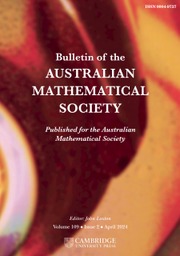No CrossRef data available.
Article contents
SUMS OF SQUARES OF INTEGERS EXCEPT FOR A FIXED ONE
Published online by Cambridge University Press: 20 November 2025
Abstract
We study sums of squares of integers except for a fixed one. For any nonnegative integer n, we find the minimum number of squares of integers except for n whose sums represent all positive integers that are represented by a sum of squares except for n. This problem could be considered as a generalisation of the result of Dubouis [‘Solution of a problem of J. Tannery’, Intermédiaire Math. 18 (1911), 55–56] for the case when  $n=0$.
$n=0$.
Keywords
Information
- Type
- Research Article
- Information
- Copyright
- © The Author(s), 2025. Published by Cambridge University Press on behalf of Australian Mathematical Publishing Association Inc
Footnotes
The first and fifth authors were supported by National Research Foundation of Korea (NRF) grants funded by the Korea government (MSIT) (NRF-2020R1A5A1016126 and RS-2024-00342122); the second author was supported by National Research Foundation of Korea (NRF) grants funded by the Korea government (MSIT) (NRF-2021R1I1A1A01043959 and RS-2024-00342122); the sixth author was supported by a National Research Foundation of Korea (NRF) grant funded by the Korea government (MSIT) (RS-2024-00342122) and by the Czech Science Foundation (GAČR) (grant 21-00420M).


